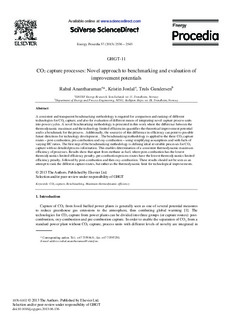| dc.contributor.author | Anantharaman, Rahul | |
| dc.contributor.author | Jordal, Kristin | |
| dc.contributor.author | Gundersen, Truls | |
| dc.date.accessioned | 2017-12-19T09:47:22Z | |
| dc.date.available | 2017-12-19T09:47:22Z | |
| dc.date.created | 2013-09-04T14:04:38Z | |
| dc.date.issued | 2013 | |
| dc.identifier.citation | Energy Procedia. 2013, 37 2536-2543. | nb_NO |
| dc.identifier.issn | 1876-6102 | |
| dc.identifier.uri | http://hdl.handle.net/11250/2472772 | |
| dc.description.abstract | A consistent and transparent benchmarking methodology is required for comparison and ranking of different technologies for CO2 capture, and also for evaluation of different means of integrating novel capture process units into power cycles. A novel benchmarking methodology is presented in this work where the difference between the thermodynamic maximum and the technology limited efficiencies quantifies the theoretical improvement potential and is a benchmark for the process. Additionally, the source(s) of this difference in efficiency can point to possible future directions for technology development. . The benchmarking methodology is applied to the three CO2 capture routes – post-combustion, pre-combustion and oxy-combustion – using simplifying assumptions and with fuels of varying HC ratios. The first step of the benchmarking methodology is defining ideal reversible processes for CO2 capture with no detailed process information. This enables determination of a consistent thermodynamic maximum efficiency of processes. Results show that apart from methane as fuel, where post-combustion has the lowest thermodynamics limited efficiency penalty, pre-combustion process routes have the lowest thermodynamics limited efficiency penalty, followed by post-combustion and then oxy-combustion. These results should not be seen as an attempt to rank the different capture routes, but rather as the thermodynamic limit for technological improvements. | nb_NO |
| dc.language.iso | eng | nb_NO |
| dc.publisher | Elsevier | nb_NO |
| dc.rights | Attribution-NonCommercial-NoDerivatives 4.0 Internasjonal | * |
| dc.rights.uri | http://creativecommons.org/licenses/by-nc-nd/4.0/deed.no | * |
| dc.title | CO2 Capture Processes: Novel Approach to Benchmarking and Evaluation of Improvement Potentials | nb_NO |
| dc.type | Journal article | nb_NO |
| dc.type | Peer reviewed | nb_NO |
| dc.description.version | publishedVersion | nb_NO |
| dc.source.pagenumber | 2536-2543 | nb_NO |
| dc.source.volume | 37 | nb_NO |
| dc.source.journal | Energy Procedia | nb_NO |
| dc.identifier.doi | 10.1016/j.egypro.2013.06.136 | |
| dc.identifier.cristin | 1046871 | |
| dc.relation.project | Norges forskningsråd: 193816 | nb_NO |
| dc.description.localcode | © 2013 The Authors. Published by Elsevier Ltd. Open access under CC BY-NC-ND license (https://creativecommons.org/licenses/by-nc-nd/3.0/) | nb_NO |
| cristin.unitcode | 194,64,25,0 | |
| cristin.unitname | Institutt for energi- og prosessteknikk | |
| cristin.ispublished | true | |
| cristin.fulltext | original | |
| cristin.qualitycode | 1 | |

